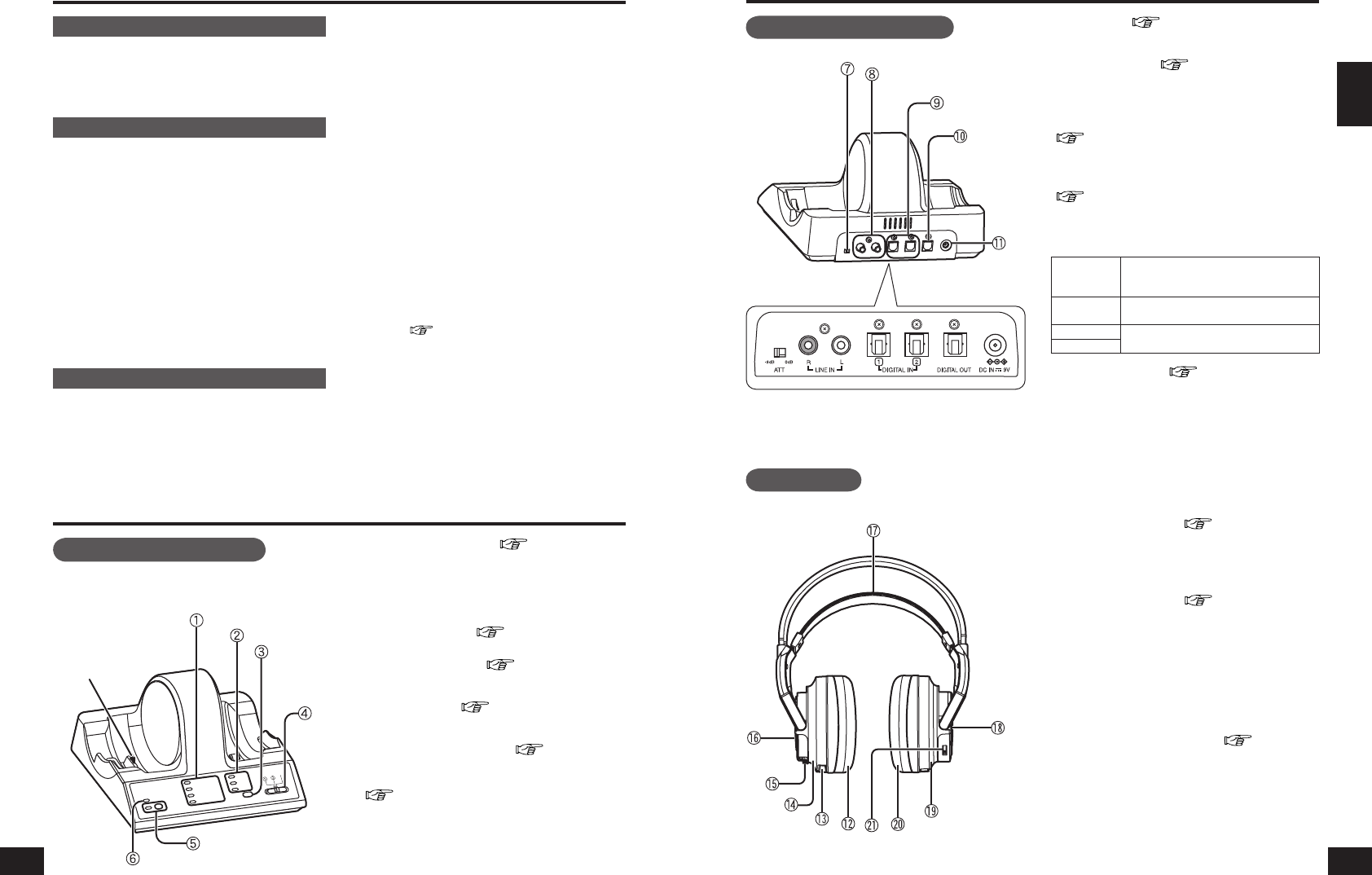
RQT8948
4
00
5
RQT8948
ENGLISH
Transmitter’s rear panel
Headphones
g
ATT control ( page 10)
Switch to [0 dB] when sound from an analog input is
low. The standard setting is [-8 dB].
h
LINE IN terminal ( page 10)
To connect to the audio out terminals of AV equipment
such as a video cassette recorder or television (not
included).
i
DIGITAL IN 1, 2 terminal (optical digital input)
( page 9)
To connect to digital equipment such as a DVD player
or a television (not included).
j
DIGITAL OUT terminal (optical digital output)
( page 9)
The same digital signal as the input signal selected
with the INPUT SELECT control is output.
● When ANALOG is selected, the same digital signal
as the input signal to DIGITAL IN 2 is output.
INPUT
SELECT
control
DIGITAL OUT
DIGITAL 1
The same signal as the signal input
to DIGITAL 1
DIGITAL 2
The same signal as the signal input
to DIGITAL 2
ANALOG
k
DC IN 9V terminal ( page 6)
To connect to the supplied AC adaptor.
(Use only the supplied AC adaptor. Use of other AC
adaptors with, for example, a different plug polarity is
dangerous and can damage the unit.)
l
Ear pad (left)
m
Charging terminal
n
Left housing
o
BATT (battery) knob ( page 6)
p
Battery compartment lid
Press BATT to open the battery compartment lid.
Use the supplied rechargeable battery or “LR6, AA”
alkaline dry cell batteries (not included).
q
Free-adjusting band ( page 8)
The power turns on automatically and the OPR lamp
lights when you put on the free-adjusting band.
r
OPR (operation) lamp
Pull up the free-adjusting band and check that the OPR
lamp glows red. You can now use the headphones.
s
Right housing
t
Ear pad (right)
u
ID button, VOL control
VOL: When adjusting the volume ( page 12)
Control reference guide
5
Transmitter’s front panel
a
DECODE MODE lamp ( pages 12 to 13)
(DOLBY DIGITAL, DOLBY PRO LOGIC II,
DTS, MPEG-2 AAC)
The transmitter automatically distinguishes the recording
method of the input signal and the DECODE MODE lamp
lights.
b
SURROUND lamp ( page 14)
(MUSIC, CINEMA, VOICE)
c
SURROUND button ( page 14)
Switch between MUSIC, CINEMA, VOICE and OFF
in SURROUND MODE.
d
INPUT SELECT ( page 12)
Switch between DIGITAL 1, DIGITAL 2 and ANALOG
input.
e
ID/TUNING button, lamp ( page 14)
Use when the radio waves are weak.
f
OPR/CHARGE (operation/charge) lamp
(
page 7)
● It glows red when the headphones are being
charged.
● It glows green when the transmitter is in operation.
● It goes out when the charging fi nishes or when
there are no audio signals input for approximately 5
minutes.
Charging terminal
AC adaptor
Handle the AC adaptor carefully. Improper handling is
dangerous.
● Do not touch it with wet hands.
● Do not place heavy objects on top of it.
Be sure to use the supplied AC adaptor.
Batteries
● The rechargeable battery can be recharged about
300 times. If it’s operating time becomes extremely
short, you should replace it.
● Do not mix old and new batteries or different types of
batteries.
●
Do not heat the batteries or expose them to flames.
● Do not recharge ordinary dry cell batteries.
● Remove the battery if the unit is not to be used for a
long time.
● Carry and store the rechargeable batteries in the
battery carrying case to prevent contact with metal
objects.
● Do not peel off the covering on batteries and do not
use if the covering has been peeled off.
Mishandling of batteries can cause electrolyte leakage
which can damage items the fl uid contacts and may
cause a fi re.
The unit
This unit uses the 2.4 GHz radio frequency band.
However other wireless equipment may use the
same frequency. Be sure to take note of the following
to prevent radio wave interference from other
equipment.
Precautions
Control reference guide
n Restriction of use
For use only in your country.
n Range of use
The range of use is up to approximately 30 m (98.4 ft.)
The range may be less depending on the structure
of the building, the environment and any obstacles
between the headphones and the transmitter.
Such obstacles as reinforced concrete walls and
metal doors, in particular, obstruct the transmitter’s
signals.
n Interference from other equipment
Due to radio interference, malfunctions such as
sound distortion may occur if the unit is placed too
close to other equipment. We recommend keeping
the unit as far away as possible from the following
devices.
Bluetooth devices, wireless LAN, microwaves,
offi ce automation devices, digital cordless
telephones and other electronic devices
The unit is designed to automatically avoid radio
interference from these household devices. However
the sound will be broken when radio interference
occurs. In this case reset the most appropriate
frequency (
page 14 [Setting the most appropriate
frequency]).
n Using the unit
● Do not drop, hit or otherwise subject the transmitter
or headphones to strong shocks of any kind. This
may damage them.
● Do not expose the unit to water or other liquids as it
may damage it.
4


















